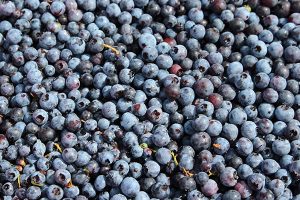Bulletin #4263, Vegetables and Fruits for Health: Wild Blueberries

Revised and updated by Extension Professional Lisa Fishman, University of Maine Cooperative Extension.
Originally developed by Extension Nutrition Specialist Nellie Hedstrom, University of Maine Cooperative Extension.
For information about UMaine Extension programs and resources, visit extension.umaine.edu.
Find more of our publications and books at extension.umaine.edu/publications/.
Native wild blueberries are a part of Maine’s heritage. We look forward to juicy, fresh blueberries each summer. With the growing evidence that blueberries have extraordinary health benefits, we are fortunate that frozen, canned, or fresh blueberries are available throughout the year.
Maine produces more wild blueberries than any other state. The lowbush berry grown in Maine is valued for its small size and sweet taste. The larger, cultivated highbush berry is also becoming popular in Maine markets.
Nutrition Information
Studies indicate that wild blueberries help keep us healthy and may even slow the effects of aging, particularly loss of memory and motor skills. The health benefits of blueberries stem largely from the antioxidant capacity of the blue pigments, (anthocyanins), as well as other natural compounds. In fact, blueberries have more antioxidant capacity than 40 other fruits and vegetables tested. There is evidence that the blue in the berries may have cancer-fighting properties and protect against heart disease.
At the same time, important nutrients such as fiber, vitamin C, and potassium are available in every dish of blueberries you eat. Just one cup of wild blueberries provides 14 percent of the Recommended Daily Allowance for vitamin C, and 4 grams of fiber. The caloric value of blueberries is low and they contain no fat, making them a perfect anytime food.
Selection
Choose blueberries that are navy blue and have a powdery, silver-white surface. The berries should be plump and have smooth skins. The best berries are fully ripe, not overripe or green. If possible, go to the fields and buy berries directly from growers during harvest season. Buy your supply when berries are at their peak, from July to mid-August.
Storage
Like other fruits, blueberries are highly perishable if not held under ideal conditions. If you are buying blueberries from the market, buy them where they have been kept cool. Freezer-ready berries, which have been sorted and sifted, will cost slightly more, but will save you time.
Berries from farmers markets or fields may contain field debris such as leaves and stems. Take time to remove this debris, as well as any underripe green berries, before rinsing and storing. Rinse berries in cool water and drain well in a colander. Store cleaned berries in the crisper section of the refrigerator and use within one to two weeks.
To freeze berries, pack them after rinsing and draining. Use moisture- and vapor-proof bags or other containers for long freezer storage. Mark and freeze immediately. When you want to use the berries, take out as many as you need.
Preparation
Fresh blueberries can be eaten in a variety of ways. Adding them to coffee cakes, pancakes, muffins, pies, and cereal has traditionally been popular. Now fresh blueberries are also appearing in beverages, salads and salad dressings, side dishes, and entrees. If the berries are frozen use them directly from the freezer. There’s no need to thaw them if you use them in baked products.
Lemon Blueberry and Chicken Salad
Serves 4
2 cups fresh or frozen blueberries
3/4 cup low-fat lemon yogurt
3 tablespoons reduced-calorie mayonnaise
2 cups cooked, cubed chicken
1/2 cup sliced green onions (scallions)
3/4 cup sliced celery
1/2 cup diced sweet red bell pepper
a few blueberries for garnishing
In a bowl, combine the yogurt and the mayonnaise until smooth. Add the remaining ingredients and mix gently. Cover and refrigerate at least 30 minutes to let flavors blend.
Blueberry Scones
Makes 8 scones
2 cups flour
3 teaspoons baking powder
1/2 teaspoon salt
2 tablespoons sugar, divided
1/4 cup margarine
3/4 cup fresh blueberries
1 egg, beaten
1/2 cup 2% milk
Preheat oven to 450ºF. Combine flour, 1 tablespoon of the sugar, baking powder, and salt in a bowl. Cut in margarine until mixture is crumbly. Add blueberries and toss lightly to coat. In a small bowl, combine beaten egg and milk. Add all at once to the flour mixture and stir just until combined. Over-mixing will result in tough scones. Pat dough out onto a lightly floured surface to a 3/4-inch thickness. Cut into diamond shapes or triangles. Sprinkle with the remaining sugar. Bake on an ungreased cookie sheet for 20 to 25 minutes.
Some content adapted with permission from University of Massachusetts Cooperative Extension.
Information in this publication is provided purely for educational purposes. No responsibility is assumed for any problems associated with the use of products or services mentioned. No endorsement of products or companies is intended, nor is criticism of unnamed products or companies implied.
© 2008
Call 800.287.0274 (in Maine), or 207.581.3188, for information on publications and program offerings from University of Maine Cooperative Extension, or visit extension.umaine.edu.
In complying with the letter and spirit of applicable laws and pursuing its own goals of diversity, the University of Maine System does not discriminate on the grounds of race, color, religion, sex, sexual orientation, transgender status, gender, gender identity or expression, ethnicity, national origin, citizenship status, familial status, ancestry, age, disability physical or mental, genetic information, or veterans or military status in employment, education, and all other programs and activities. The University provides reasonable accommodations to qualified individuals with disabilities upon request. The following person has been designated to handle inquiries regarding non-discrimination policies: Director of Equal Opportunity and Title IX Services, 5713 Chadbourne Hall, Room 412, University of Maine, Orono, ME 04469-5713, 207.581.1226, TTY 711 (Maine Relay System).



